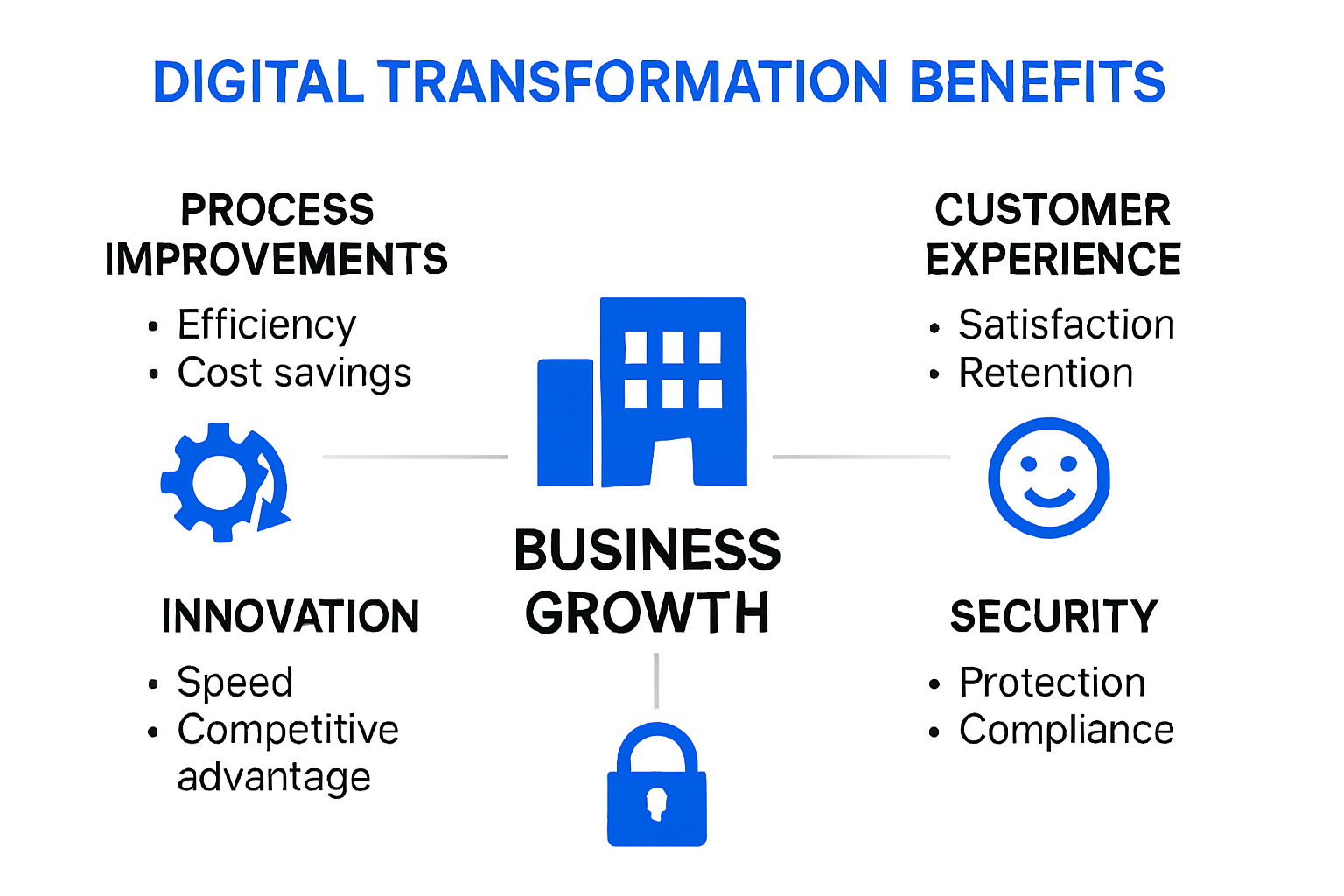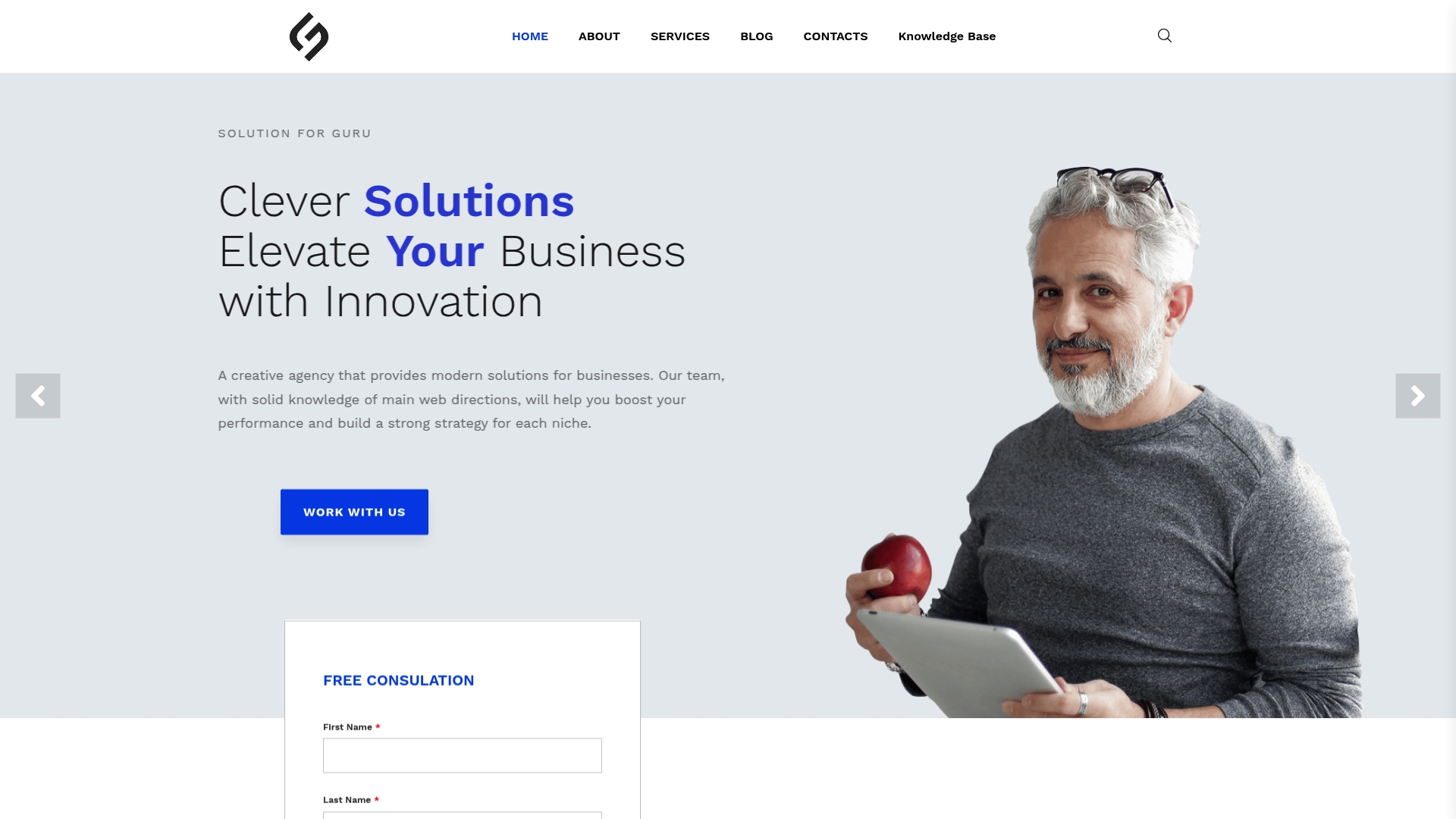Key Digital Transformation Benefits for Business Growth

Digital transformation is not just a buzzword. Across industries, companies are unlocking stunning results with technology. One study points to cost savings between $1.4 and $3 billion when digital strategies are fully embraced. Most people expect digital upgrades just make things faster or more convenient. The real surprise is how these changes completely reshape customer experiences, drive nonstop innovation, and create security ecosystems that barely existed a few years ago.
Table of Contents
- How Digital Transformation Boosts Efficiency
- Enhancing Customer Experience Through Technology
- Driving Innovation and Competitive Edge
- Improving Security and Data Protection
Quick Summary
| Takeaway | Explanation |
|---|---|
| Optimize operations with digital tools | Leverage technology to streamline processes and reduce inefficiencies for better resource management. |
| Enhance customer engagement through personalization | Utilize data analytics to create tailored experiences that meet unique customer needs, increasing satisfaction. |
| Foster a culture of innovation | Encourage continuous learning and experimentation to maintain a competitive edge in evolving markets. |
| Implement immersive security strategies | Adopt zero trust architecture and proactive monitoring to safeguard data against emerging cyber threats. |
| Drive strategic decision-making with real-time data | Use digital tools for instant insights, enabling agile responses to market changes and cost-saving opportunities. |

How Digital Transformation Boosts Efficiency
Digital transformation represents a fundamental reimagining of business operations through strategic technology integration. For modern organizations, efficiency is no longer just about working harder but working smarter by leveraging technological capabilities that streamline processes, reduce manual interventions, and optimize resource allocation.
Operational Process Optimization
Businesses implementing digital transformation can dramatically reduce operational friction and inefficiencies. The U.S. Department of the Treasury’s Office of Financial Innovation and Transformation (FIT) revealed potential cost savings between $1.4 to $3.0 billion through comprehensive digital process redesign. These savings emerge from eliminating redundant workflows, automating repetitive tasks, and creating more transparent, interconnected operational systems.
Digital tools enable real-time data collection and analysis, allowing businesses to make informed decisions quickly. Automated workflows reduce human error, accelerate task completion, and free up employees to focus on higher-value strategic activities. For instance, implementing enterprise resource planning (ERP) systems can consolidate multiple business functions into a unified platform, reducing communication gaps and enhancing overall organizational responsiveness.
Technology-Driven Productivity Enhancements
The International Monetary Fund’s research demonstrates that digital technologies can significantly improve operational productivity. By adopting advanced technologies like artificial intelligence, machine learning, and cloud computing, businesses can achieve unprecedented levels of efficiency. These technologies enable predictive analytics, automated decision-making, and sophisticated resource allocation strategies.
For example, AI-powered chatbots can handle customer service inquiries 24/7, reducing wait times and human resource expenditure. Machine learning algorithms can optimize supply chain management by predicting demand, managing inventory levels, and identifying potential disruptions before they occur. Cloud computing allows for flexible, scalable infrastructure that adapts to changing business needs without substantial upfront hardware investments.
Financial and Strategic Efficiency Gains
Digital transformation goes beyond operational improvements to deliver strategic financial benefits. An IMF working paper highlighted that increased digital adoption correlates with improved budget transparency and more effective expenditure management. Organizations can leverage digital tools to track financial performance in real-time, identify cost-saving opportunities, and make data-driven strategic decisions.
By reducing manual processes, minimizing errors, and providing comprehensive insights, digital transformation enables businesses to allocate resources more effectively. This approach transforms efficiency from a tactical goal into a strategic advantage, positioning companies to respond rapidly to market changes and emerging opportunities.
To help clarify the core efficiency gains from digital transformation, the following table summarizes specific operational, technological, and strategic outcomes mentioned:
| Efficiency Area | Benefit/Impact | Example Technology/Method |
|---|---|---|
| Operational Process Optimization | Eliminates redundant workflows, automates repetitive tasks, and improves transparency | ERP systems, workflow automation |
| Real-time Data Collection & Analysis | Enables faster decision-making, reduces errors, and frees employees for strategic activities | Data analytics, automated dashboards |
| AI and Machine Learning | Handles customer inquiries, predicts demand, optimizes resources | AI chatbots, ML supply chain models |
| Cloud Computing | Provides scalable, flexible infrastructure without large upfront investment | Cloud platforms and services |
| Strategic Financial Management | Improves budget transparency, tracks performance, identifies cost-saving opportunities | Financial analytics tools |
Businesses committed to digital transformation recognize that efficiency is not about replacing human workers but empowering them with intelligent tools that amplify their capabilities. Learn more about cutting-edge AI tools for business efficiency to understand how technology can revolutionize your operational approach.
Enhancing Customer Experience Through Technology
Digital transformation has fundamentally reshaped how businesses interact with customers, creating more personalized, responsive, and seamless experiences across multiple touchpoints. Technology enables organizations to move beyond traditional customer service models toward dynamic, intelligent engagement strategies that anticipate and meet customer needs proactively.
Personalization and Intelligent Interactions
Research from an emerging technology journal reveals that advanced digital technologies are revolutionizing customer experience through hyper-personalization. Machine learning algorithms analyze customer data to create individualized interactions, recommendations, and service pathways. By understanding customer preferences, behavior patterns, and historical interactions, businesses can craft experiences that feel uniquely tailored to each individual.
For instance, AI-powered recommendation engines can suggest products based on previous purchases, browsing history, and predictive analytics. Chatbots equipped with natural language processing can provide instant, contextually relevant support, understanding customer inquiries with remarkable accuracy and offering solutions in real-time.
Omnichannel Service Strategies
A comprehensive study on digital service strategies highlights the critical importance of seamless omnichannel experiences. Modern customers expect consistent interactions across websites, mobile apps, social media platforms, and physical stores. Digital transformation enables businesses to create unified customer journey maps that maintain context and quality regardless of the interaction channel.
Technologies like cloud computing and integrated CRM systems allow businesses to synchronize customer data across platforms. This means a customer can start an inquiry on a mobile app, continue it via email, and complete the interaction in a physical store without losing context or experiencing friction. Such seamless experiences significantly enhance customer satisfaction and brand loyalty.
Performance and Strategic Customer Engagement
Research examining digital transformation’s impact on firm performance demonstrates that strategic technology adoption directly correlates with improved customer experience and financial outcomes. By leveraging data analytics, businesses can gain deep insights into customer behavior, preferences, and potential pain points.
Digital tools enable real-time feedback collection, sentiment analysis, and predictive customer behavior modeling. Companies can proactively address potential issues, design more intuitive product experiences, and create targeted marketing campaigns that resonate with specific customer segments.
Businesses seeking to enhance their customer engagement strategies can explore advanced CRM automation tools that transform how they interact with and understand their customer base. The future of customer experience lies in intelligent, adaptive technologies that make every interaction more meaningful and personalized.
Driving Innovation and Competitive Edge
Digital transformation has become a critical catalyst for driving innovation and maintaining competitive advantage in today’s rapidly evolving business ecosystem. Organizations that successfully integrate advanced technologies can create dynamic capabilities that enable them to anticipate market changes, develop groundbreaking solutions, and stay ahead of emerging industry trends.
Enhancing Organizational Innovation Capacity
A comprehensive study published in Heliyon reveals that digital transformation significantly amplifies corporate innovation performance. The research demonstrates how big data capabilities and organizational agility serve as crucial mediating factors in transforming technological investments into innovative outcomes. Companies that strategically deploy digital technologies can develop more responsive and adaptive innovation frameworks.
Modern digital tools like artificial intelligence, machine learning, and advanced analytics provide businesses with unprecedented insights into market dynamics, customer preferences, and potential innovation opportunities. These technologies enable organizations to rapidly prototype, test, and iterate new products and services, dramatically reducing the time and resources traditionally required for innovation cycles.
Strategic Competitive Positioning
Research in the UBRU International Journal highlights how digital transformation strategies directly influence sustainable business development. The study emphasizes that successful digital initiatives not only enhance financial performance but also facilitate market expansion and support broader organizational objectives.
Organizational culture emerges as a critical determinant in successfully implementing digital transformation. Companies that foster a culture of continuous learning, experimentation, and technological adaptability are more likely to develop innovative solutions that differentiate them from competitors. This involves creating environments that encourage cross-functional collaboration, support risk-taking, and value technological experimentation.
Leadership and Dynamic Capabilities
An investigation in the Dinasti International Journal underscores the pivotal role of transformational leadership in driving competitive advantage during digital disruption. Leaders who champion technological innovation and cultivate flexible organizational structures are better equipped to navigate complex market landscapes.
Transformational leaders recognize that competitive edge is not just about adopting new technologies but about creating adaptive ecosystems that can quickly respond to emerging challenges. This involves developing dynamic capabilities that allow organizations to sense market shifts, seize new opportunities, and continuously reconfigure internal resources and competencies.
Businesses seeking to accelerate their innovation potential can explore cutting-edge AI tools for business transformation that provide strategic insights and enable more agile decision-making. The future belongs to organizations that view digital transformation not as a one-time project, but as an ongoing journey of continuous innovation and adaptation.
Improving Security and Data Protection
Digital transformation has fundamentally reshaped organizational approaches to cybersecurity, moving beyond traditional perimeter-based defense strategies toward more comprehensive, adaptive security frameworks. As businesses increasingly rely on digital technologies, protecting sensitive data and maintaining robust security infrastructures have become critical components of sustainable growth and operational resilience.
Zero Trust Architecture and Advanced Security Frameworks
The National Institute of Standards and Technology (NIST) Special Publication 800-207 introduces zero trust architecture as a revolutionary approach to cybersecurity. Unlike traditional models that assume trust within internal networks, zero trust operates on the principle of continuous verification. This means every access request is thoroughly authenticated, authorized, and encrypted, regardless of its origin.
Modern digital transformation strategies incorporate multi-factor authentication, advanced encryption protocols, and real-time threat detection mechanisms. These technologies enable businesses to create dynamic security environments that can adapt to evolving cyber threats. Machine learning algorithms can now analyze network traffic patterns, identify potential anomalies, and respond to security incidents with unprecedented speed and precision.
Cloud Security and Data Protection Strategies
A comprehensive report from the U.S. Government Accountability Office emphasizes how digital modernization efforts significantly enhance data protection capabilities. Cloud computing platforms now offer sophisticated security features that go far beyond traditional on-premises solutions. These include advanced encryption at rest and in transit, granular access controls, and comprehensive audit trails that provide complete visibility into data interactions.
Businesses can now implement robust data governance frameworks that ensure compliance with complex regulatory requirements. Advanced cloud security tools enable organizations to classify sensitive information, monitor data flows, and automatically enforce security policies across diverse digital environments. This approach not only protects against external threats but also mitigates internal risks associated with unauthorized data access or accidental exposure.
Proactive Threat Management and Continuous Monitoring
Digital transformation has shifted cybersecurity from a reactive to a proactive model. Organizations can now leverage predictive analytics and artificial intelligence to anticipate and prevent potential security breaches before they occur. Continuous monitoring systems provide real-time insights into network vulnerabilities, allowing businesses to address potential risks dynamically.
Integrated security information and event management (SIEM) systems collect and analyze data from multiple sources, creating a comprehensive view of an organization’s security posture. These advanced platforms can correlate complex security events, identify potential threats, and provide actionable intelligence that enables rapid response to emerging cybersecurity challenges.
This table outlines the key cybersecurity advancements enabled by digital transformation, uniquely organizing the main approaches and benefits presented:
| Security Approach | Key Features | Benefits |
|---|---|---|
| Zero Trust Architecture | Continuous verification, access authentication, data encryption | Protects against internal and external threats |
| Multi-factor Authentication (MFA) | Layered verification processes | Reduces risk of unauthorized access |
| Cloud Security | Encryption at rest/in transit, granular controls, audit trails | Enhances data protection and compliance |
| Proactive Threat Management | AI-driven anomaly detection, continuous monitoring | Allows for rapid and preventive responses |
| Data Governance Frameworks | Classification, policy enforcement, monitoring data flows | Ensures regulatory compliance, reduces risk |
Companies looking to enhance their security strategies can explore advanced security integration techniques that leverage cutting-edge technologies. The future of cybersecurity lies in creating adaptive, intelligent systems that can anticipate, prevent, and respond to threats with unprecedented sophistication and efficiency.

Frequently Asked Questions
What are the primary benefits of digital transformation for businesses?
Digital transformation helps businesses enhance operational efficiency, improve customer experiences, drive innovation, and bolster security. By leveraging technology, organizations can streamline processes, personalize services, and respond agilely to market changes.
How does digital transformation improve customer experience?
Digital transformation enhances customer experience through personalization and seamless omnichannel interactions. By using data analytics and advanced technologies, businesses can create tailored experiences that meet individual customer needs and maintain context across various platforms.
What role does technology play in driving business innovation?
Technology is a crucial driver of innovation in business by enabling faster prototyping, testing, and implementation of new products and services. It allows organizations to harness big data, AI, and machine learning to identify new opportunities and adapt to market demands quickly.
How can businesses improve their cybersecurity through digital transformation?
Businesses can enhance cybersecurity by adopting advanced security frameworks such as zero trust architecture, multi-factor authentication, and cloud security solutions. These strategies allow for continuous monitoring, proactive threat management, and compliance with regulatory requirements.
Ready to Transform and Accelerate Your Business Growth?
If you are struggling with inefficiencies, inconsistent customer experiences, or the fear of falling behind in a rapidly changing digital world, now is the time to act. The article revealed how digital transformation unlocks higher productivity, enhanced security, and a customer-first strategy that shapes lasting business success. But understanding the technology is only the first step. What truly matters is having the right digital partner who turns these insights into action with solutions customized for you.

Experience what modern technology can really do for your business. Solution4Guru delivers advanced digital transformation strategies including AI integration, web development, and automation proven to boost performance and protect your company. Discover how you can streamline operations and impress your customers by requesting a free consultation with our expert team. Let us show you real results like those in our client success stories. Take your next step toward a future-ready business today.


